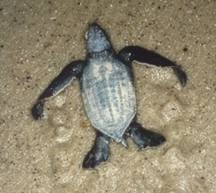 |
| Leatherback Turtle Basic Information: Latin Name: Taxonomic Group: Risk Category: Range: Year of Designation: |
 |
| Dermochelys coriacea Reptiles Endangered Atlantic and Pacific Oceans, British Columbia, New Brunswick, Newfoundland, Nova Scotia, Prince Edward Island 1981 |
| >> |
| >> |
| The Leatherback Turtles are the largest living turtles in the world. The shell of an adult is black, while the younge have a mottled appearence. Its shell is skin with small bones imbedded in it with no claws. They can measure up to 2.4 m in length and 3.6 m in width, and can weigh up to 725kg. These turtles are very strong swimmers at sea where they spend most of their time, except at shore to lay eggs. They also nest in specific areas in tropical or sub-tropical waters and travelwidely in temerate waters. The main threats to these turtles are poor nesting. Other factors are collectin of eggs by humans, natural predation by other species, human involvement due to commerical development on beaches where turtles nest, pollution on shorelines, and plastic and other debris that is ingested by adult turtles. There are no estimates presentaly of the number of Leatherback Turtles in Canada. They have been sighted off the east coast of Canada between June and October, with few sightings elsewhere than Canada. What we know about the world-wide population is very small and is declining. For the Atlantic Ocean population, Dalhousie University held the first North Atlantic Leatherback Turtle workshope in 1996 for a source of a recovery effort. In 1995 researchers have been trying to fit turtles with mini-computers that will tract their medical informaion (such as heart rate, body temperature, ect.). By 1997 this research grew to include monitoring of food ingestion and metabolism. |